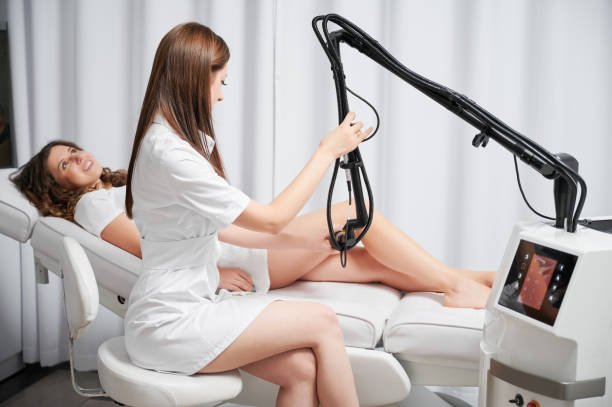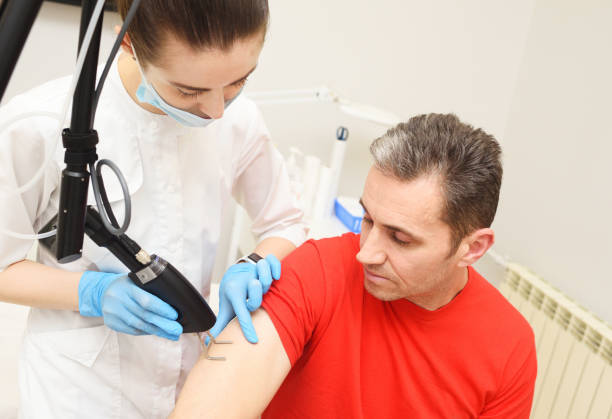Fractional CO2 laser treatment Abu Dhabi has gained popularity as an effective solution for various skin concerns, including wrinkles, acne scars, and uneven skin tone. However, one of the most pressing questions surrounding this treatment is its safety across different skin types. This article aims to explore whether fractional CO2 laser treatment is suitable for all skin types, considering factors like effectiveness, safety, and potential side effects.
Understanding Fractional CO2 Laser Treatment
Fractional CO2 laser treatment utilizes carbon dioxide lasers to create microscopic wounds in the skin. This process stimulates collagen production and promotes skin regeneration. The term “fractional” refers to the laser’s ability to treat only a fraction of the skin at a time, leaving surrounding tissue unharmed. This unique approach allows for quicker recovery times and reduces the risk of complications compared to traditional CO2 lasers, which ablate the entire skin surface.

Skin Types and Laser Treatment
The Fitzpatrick scale is commonly used to categorize skin types based on their response to UV exposure. It ranges from Type I (very fair skin that burns easily) to Type VI (dark brown to black skin that rarely burns). The safety and effectiveness of fractional CO2 laser treatment can vary significantly across these skin types:
- Light Skin Types (I-III): Individuals with lighter skin generally experience fewer complications from fractional CO2 laser treatment. Their skin tends to heal more effectively, and the risk of hyperpigmentation (darkening of the skin) is lower. They often see satisfactory results with minimal downtime.
- Medium Skin Types (IV-V): For medium skin types, the treatment can still be effective, but dermatologists may recommend a more cautious approach. Pre-treatment assessments and adjustments to the laser settings might be necessary to mitigate risks. While the results can be favorable, there’s still a potential for increased sensitivity and a longer healing time.
- Dark Skin Types (VI): Darker skin types are at a higher risk for complications such as post-inflammatory hyperpigmentation, where the treated area becomes darker due to skin trauma. Therefore, dermatologists often approach fractional CO2 laser treatment with greater caution for these patients. Alternative treatments or additional precautions, like using topical lightening agents before the procedure, may be recommended to reduce the risk.
Effectiveness of Fractional CO2 Laser for Different Skin Types
The effectiveness of fractional CO2 laser treatment also varies with skin type:
- Efficacy in Light Skin: For light-skinned individuals, fractional CO2 laser treatment has been shown to produce excellent results in improving skin texture, reducing fine lines, and treating acne scars. The recovery period is generally shorter, and the results can be long-lasting.
- Efficacy in Dark Skin: In darker skin types, while the treatment can still yield good results, the risk of complications makes it essential for patients to work closely with experienced dermatologists. Specialized techniques and adjustments may be required to optimize outcomes and minimize risks.
Potential Risks and Side Effects
Like any medical procedure, fractional CO2 laser treatment comes with potential risks and side effects, which can vary by skin type:
- Common Side Effects: These include redness, swelling, and peeling, which are typical post-treatment reactions. Most of these effects are short-lived, but their intensity can differ based on skin type.
- Hyperpigmentation: As previously mentioned, darker skin types are particularly susceptible to hyperpigmentation following treatment. This occurs when the skin overproduces melanin in response to inflammation or injury.
- Other Complications: Less commonly, patients may experience acne-like eruptions, bacterial infections, or prolonged redness. The importance of adhering to post-treatment care guidelines cannot be overstated, especially for darker skin types.
Consultation and Preparation
Before undergoing fractional CO2 laser treatment, a thorough consultation with a qualified dermatologist is essential. They can assess your skin type and recommend the most suitable treatment plan, including:
- Customized Laser Settings: Adjusting the laser’s intensity and treatment depth based on skin type can help minimize risks and enhance results.
- Pre-Treatment Care: For darker skin types, pre-treatment care might involve the use of topical lighteners or anti-inflammatory medications to reduce the risk of pigmentation issues.
- Post-Treatment Protocols: Aftercare is crucial to ensuring proper healing and preventing complications. This includes using gentle skincare products, avoiding sun exposure, and following any specific instructions provided by the dermatologist.
Conclusion
Fractional CO2 laser treatment is a powerful tool for skin rejuvenation, but its safety and effectiveness can vary significantly based on skin type. While light skin types generally experience fewer complications and faster healing, individuals with darker skin should approach the treatment with caution and consult with an experienced dermatologist. By tailoring the treatment plan to individual skin characteristics and adhering to pre- and post-treatment protocols, patients can achieve optimal results while minimizing risks.
FAQs
- Is fractional CO2 laser treatment safe for all skin types?
- While it can be effective for various skin types, lighter skin types generally face fewer risks compared to darker skin types, which are more prone to hyperpigmentation.
- What should I expect during the treatment?
- Most patients report mild discomfort, often managed with topical anesthetics. The procedure can take anywhere from 30 minutes to a couple of hours, depending on the treatment area.
- How long is the recovery period?
- Recovery time varies; light skin types might heal within a few days, while darker skin types may require more time for healing.
- Can I wear makeup after the treatment?
- It is typically advised to avoid makeup for a few days post-treatment to allow the skin to heal properly.
- What are the common side effects?
- Common side effects include redness, swelling, and peeling. These effects are generally temporary but can vary based on skin type.
- How can I minimize risks associated with treatment?







